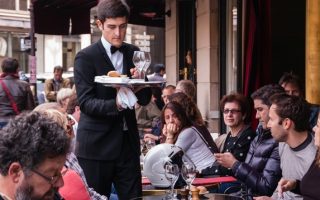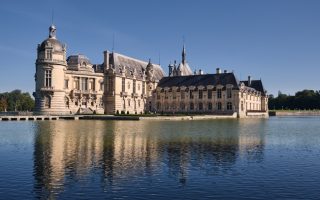Explore Troyes, the City Shaped like a Champagne Cork
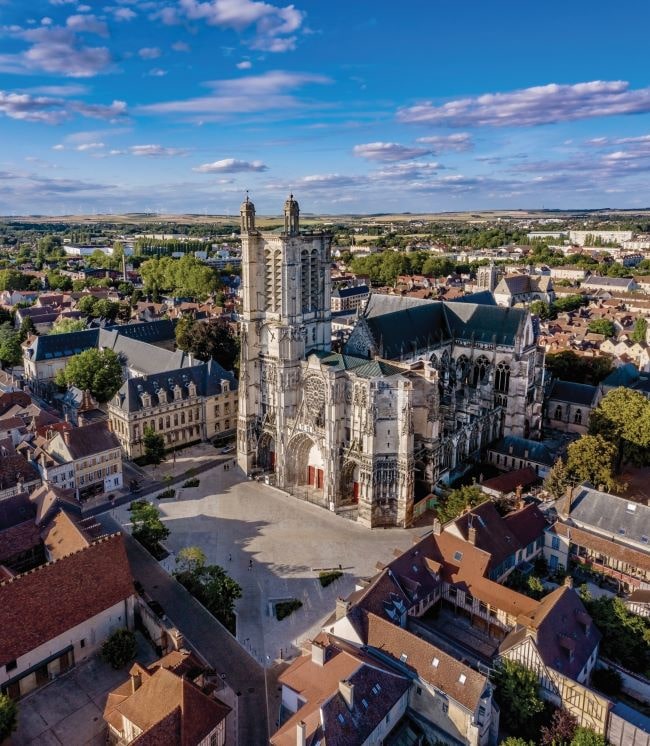
Gillian Thornton enjoys colourful buildings, rich artworks and bargain shopping in Troyes
You don’t need to spend very long in Troyes to understand why this enchanting city proudly proclaims itself the ‘land of a thousand colours’. Just wander the atmospheric streets of the medieval Old Town to find half-timbered houses in shades ranging from pastel peach to vibrant pistachio, and rich raspberry to golden yellow.
And the rainbow colours carry on inside too. The historic seat of the Counts of Champagne, Troyes (the departmental capital of Aube-en-Champagne) is renowned as the French capital of both stained-glass and bargain shopping. Prepare to be dazzled by the glorious windows of the city’s many ancient churches and, in complete contrast, the multi-coloured temptations of the outlet shopping malls.

Le Coeur de Troyes de Michèle et Thierry Kayo-Houël © Laetitia Dagard -Troyes Champagne Tourisme
As for the champagne cork shape of the Old Town – the ‘Bouchon de Champagne’ – this wasn’t some clever piece of marketing by an historic wine merchant, but a happy accident that could be regarded as an omen of things to come. The cork-shape of the city centre was, in fact, defined by the medieval ramparts, laid out some five centuries before the sparkling drink was created, according to legend at least, by Dom Pérignon. Today the surrounding department of Aube is the second largest producer of champagne after the Marne, with the vineyards of Montgueux just a few kilometres from the heart of Troyes.
Stop first, though, in rue Aristide Briand on the edge of the pedestrian zone to pick up a map from the Tourist Office, and admire its magnificent timber-framed home that dates from the 16th century. Then just wander the streets of the ‘Bouchon’, camera at the ready. Today the picturesque city centre is beautifully maintained, the streets and squares a mix of Renaissance stone houses and timber- framed properties with wonderfully wonky woodwork and grand gables – but Troyes hasn’t always looked so appealing.
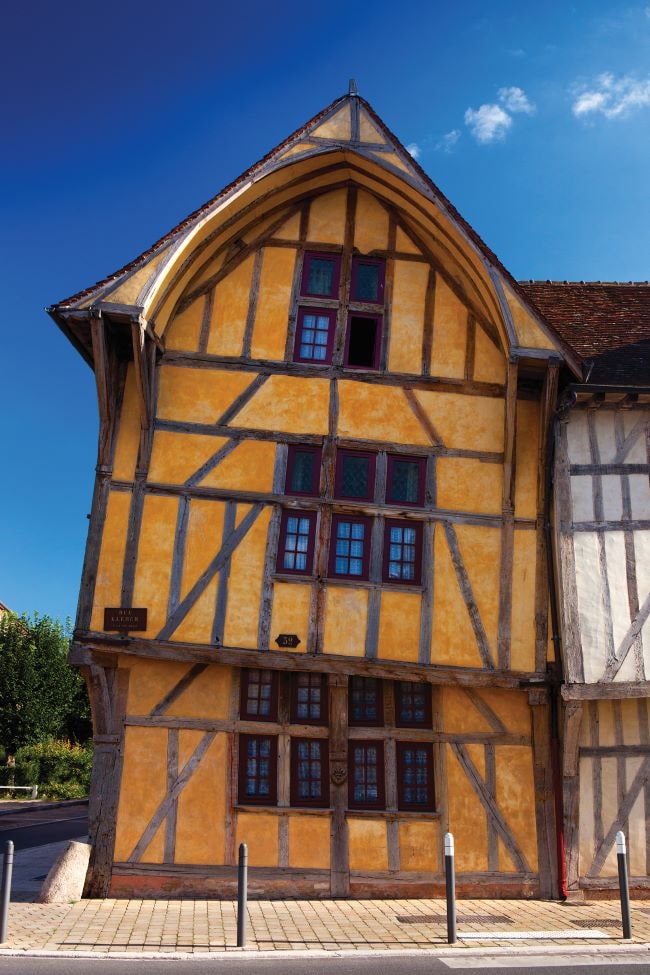
Maison du Dauphin © Studio OG – Troyes La Champagne Tourisme
FROM THE ASHES
In medieval times, houses were built in wood from the nearby Orient Forest, but in 1524, a catastrophic fire reduced some 1,500 properties to ashes, leaving 7,500 people homeless. Rich Troyens chose to rebuild in stone, leaving less wealthy citizens to start again in timber, and it’s this dramatic blend of styles that has given the city centre its unique architectural legacy. After rapid commercial expansion in the Middle Ages, 16th-century Troyes witnessed not only a construction boom, but also a flourishing of the arts, whilst the 19th century brought economic prosperity through the hosiery industry. But by the end of the Second World War, many residents were living in slum conditions. Large areas of the city centre were demolished and many 16th-century buildings lost forever. It wasn’t until the 1960s that Troyes took stock of its architectural heritage and began to preserve it, leading to the city’s fourth ‘golden age’. The effort has stepped up a gear since the turn of the millennium and 2022 sees the reopening of three major city museums after significant enhancements.
Troyens are proud of their city so it’s not surprising that a favourite photo opportunity for locals and visitors alike is the Heart of Troyes, a giant heart-shaped metal sculpture surrounded by water jets. Situated opposite the Théâtre de Champagne, this much-loved emblem stands on the banks of the former canal between the head and the body of the ‘Bouchon’. Stop by in the evening to see the heart glow red when you approach, and don’t miss a photo opportunity with the nearby statue of ‘Lili, la dame au chapeau’.

Lili © D. Le Névé – Troyes La Champagne Tourisme
You could happily wander the picturesque streets and just soak up the atmosphere, but Troyes richly rewards visitors with its history and cultural attractions. Discover the story behind the ‘shameful’ 1420 Treaty of Troyes in which the French and English kings agreed that an English king – then Henry V – would rule both kingdoms. Visit the Church of Saint-Jean-au-Marché where Henry married Catherine of Valois, daughter of Charles VI of France, and then contemplate how Europe might have looked if a second Treaty of Troyes in 1564 hadn’t revoked the first!
But the real glory of the city’s churches is the stained-glass. Troyes and the Aube are home to the largest collection of painted stained- glass windows in Europe – 1,500m2 in the cathedral alone and 9,000 in the surrounding département. And you don’t need to be an art aficionado to appreciate them.
After three years of refurbishment, the Cité du Vitrail – or Stained-Glass Discovery Centre – reopens this year in the Hôtel-Dieu-le-Comte, with a substantial area entirely dedicated to the art of stained-glass from the 12th to the 21st century. Discover the city’s expertise, not just through history and techniques, but workshops, immersive experiences and film. Also sporting a new look, the Apothecary Museum in the same building will be showcasing a collection of wooden medicine boxes and pharmaceutical jars spanning the 16th to 19th centuries, as well as a laboratory with scientific objects. There’s been a makeover, too, for the Museum of Modern Art, housed in the atmospheric surroundings of the former bishop’s palace. Expect a revised route through the permanent collection as well as new areas for graphic arts and temporary exhibitions, a new shop and sculpture garden. The eclectic collection of more than 2,000 works includes artists such as Matisse, Dufy, Modigliani, Picasso and Cézanne. If you’re still craving culture, head to Musée Saint-Loup, the city’s excellent museum of archaeology, natural history and fine arts. Enjoy a spot of DIY or craft? Then draw inspiration from the Tools and Trade Museum, a collection of 11,000 tools from the 17th and 18th centuries. Unique in France, it was founded by the French Guild of Travelling Craftsmen in 1974 and is housed in the Renaissance-built Hôtel de Mauroy.
Another unique collection resides within the ultra-modern architecture of the Jacques Chirac Media Library. Here, in addition to the public lending library, the Grande Salle is home to some 50,000 printed books, including medieval manuscripts from Clairvaux Abbey and the private collection of the Counts of Champagne.

Vitrail Création des astres – Sainte Madeleine © D. Le Névé – Troyes La Champagne Tourisme
FASHIONABLE ATTRACTIONS
But Troyes isn’t all about the past. The city grew up around the Seine and its tributaries, the Counts of Champagne creating canals to irrigate the city centre and provide water for industry. Many channels were diverted underground but water features are taking centre stage again – including the Seine itself – and one bank of the old canal has been redeveloped for pedestrians and cyclists.
Water was hugely important to the city’s long history of textile manufacturing and amongst several iconic brands born in Troyes are Lacoste and Petit Bateau. Overseas competition sent the industry into decline after its peak in the 1970s, but Troyes is still known as the knitwear capital of France and amongst brands still manufactured in the town today are agnès b. and Sonia Rykiel.
Shoppers can browse the boutiques beneath the half-timbered properties in the town centre, stopping to enjoy a drink and a bite to eat while soaking up the surroundings at a well-placed restaurant or café terrace. But for serious shoppers, there’s only one place to go. The capital of European outlet shopping, Troyes boasts more than 250 shops and 400 big-name brands concentrated in four separate centres on the outskirts of the city. Attracting in the region of 3.5 million visitors every year, they offer permanent discounts of between 30 and 50 per cent. With savings like that, you can shop till you drop and still have money left over for champagne!
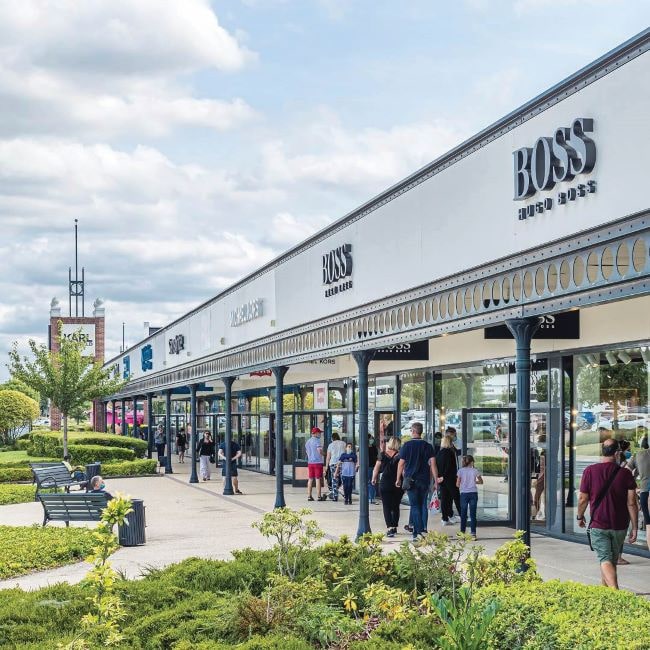
Outlet Shopping Mall, Photo: Mcarthur Glen
TROYES ESSENTIALS
GETTING THERE
Two hours from Paris by car, 1.5 hours from Reims, on the A5 motorway; 1.5 hours by train from Paris Est.
WHERE TO STAY
Opening later this year is the 5* Hôtel La Licorne, an M Gallery Hôtel and spa complex in the city centre. In the meantime, the half-timbered 5* Maison de Rhodes is the ultimate special occasion hotel. www.maisonderhodes.com
TOURIST OFFICE
Visit the Tourist Office at 16 rue Aristide Briand.Tel: 03 25 82 62 70.The new look City Pass is a magnetic card giving access to specific museums as well as gourmet and shopping offers. Choose from 24, 48 or 72 hours for €15, €20 or €25. www.troyeslachampagne.com

Nuits de Champagne 2021, Photo: José Garandel
FIVE MUST-VISIT SITES IN TROYES
Troyes is the perfect mix of history and architecture alongside shopping and festivals – here our five of our favourite things to do and see
LA RUELLE DES CHATS
Arguably the city’s most iconic street, this narrow alley is so named because it was said that a cat could jump between opposite roofs and lofts.Three new timber-framed houses were added in 2014, based on old postcards and period engravings.
SAINT-PIERRE AND SAINT-PAUL CATHEDRAL
Built over 400 years, this masterpiece of Gothic art was never completed. Missing one of its twin towers, it has a certain lopsided charm, but the interior is a stunner with more than 1,500m2 of stained glass and treasures including medieval enamel, an 11th-century Byzantine box, and the shrine of Saint Bernard.
LA CITÉ DU VITRAIL
Due to reopen this year (check website), the stained-glass discovery centre is housed within the 18th-century Hôtel-Dieu-le-Comte and covers the history and techniques used by skilled craftspeople in Troyes and the Aube. The restored chapel has stained glass ancient and modern. cite-vitrail.aube.fr
OUTLET SHOPPING
Visit Marques City (sporty, urban style), McArthurGlen shopping village (premium and luxury brands) and Village de Marques (American-style fashion) at Port-Sainte-Marie, 5km north-east of Troyes. Marques Avenue at Saint-Julien-les-Villas, 3km to the south-east, offers 50 fashion and home stores.
PARTY TIME
La Route du Champagne festival (July 30-31); Festival Ville en musiques (every weekend from end June to end August);The 48 Hours Automobiles de Troyes (September 9-11); Festival des Nuits de Champagne, musical events for voice, October 24-30. www.nuitsdechampagne.com
From France Today magazine
Lead photo credit : Cliche Cathedral © BC Image
Share to: Facebook Twitter LinkedIn Email
More in champagne, Must Visits in Troye, Troyes
Leave a reply
Your email address will not be published. Required fields are marked *

